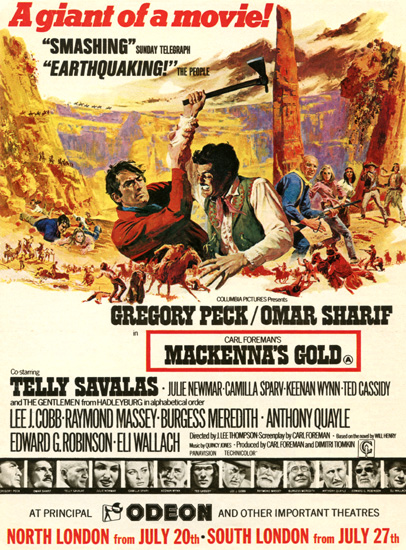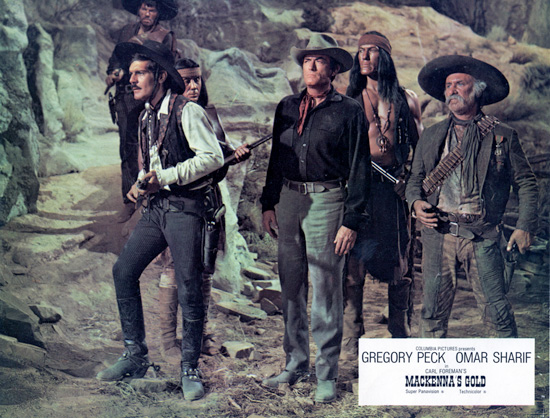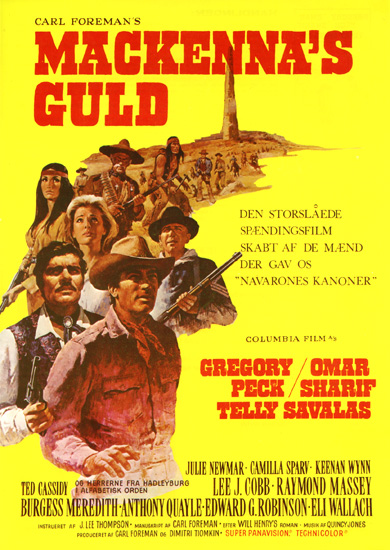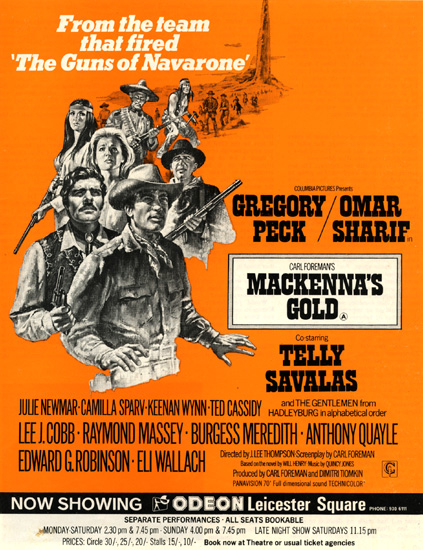"MacKenna's Gold" at the Schauburg |
Read more at in70mm.com The 70mm Newsletter |
| Written by: in70mm.com/Schauburg Cinerama Press Release | Date: 15.08.2015 |
 Schauburg
Cinerama and in70mm.com are proud to announce a rare presentation of a Carl
Foreman production of a J. Lee Thomson film "MacKenna's Gold" from
1969 on Thursday 8. October, 2015, at 21:20. The film will presented in 35mm Technicolor and
4-track magnetic stereo - with a little surprise. Schauburg
Cinerama and in70mm.com are proud to announce a rare presentation of a Carl
Foreman production of a J. Lee Thomson film "MacKenna's Gold" from
1969 on Thursday 8. October, 2015, at 21:20. The film will presented in 35mm Technicolor and
4-track magnetic stereo - with a little surprise.Projected with Schneider's Premiere ES Cinelux projection lens, with integrated anamorphic elements. "This is a very rare title for a 70mm festival. To my knowledge, "MacKenna's Gold" in Super Panavision 70 has not been shown anywhere during the past 20+ years, maybe even longer. It is a German dub, however, and I know many will reject the opportunity to come and see it because of this. I really think they should come anyway and enjoy the film in a cinema - German dub or not. What does it matter? You cannot see this in a proper roadshow cinema anywhere but here". Thomas, editor in70mm.com Egyptian actor Omar Sharif passed away some months ago and this is our farewell tribute to the greatest film doctor of all time. From playing Doctor Zhivago to a Mexican bandit, his talent was far reaching. "MacKenna's Gold" was the pinnacle of his acting career in the '60s. This presentation is the unofficial opening of the annual Todd-AO 70mm-Festival at the Schauburg Cinerama in Karlsruhe, Germany which begins Friday morning and continues for three days with a diverse program of no less than 11 (eleven) 70mm films on the big curved screen. Booking and tickets are available from schauburg.de. |
More in 70mm reading: 11. Todd-AO 70mm-Festival 2015 Motion pictures photographed in Super Panavision 70 Omar Sharif Passed Away Internet link: • Schauburg.de • On line ticket reservation • Hotel reservation link (coming soon) Filmtheater Schauburg Att: Herbert Born Marienstraße 16 76137 Karlsruhe Germany Tel: +49 721 35 000 11 mobil: +49 151 1668 9172 Fax: +49 721 38 00 47 facebook.com Soundtrack Matte Painting Variety New YorkTimes TCM Film- und Ferhnsemuseum Hamburg |
 Seventeen men and four women seek a legendary cache of gold in the
territory of the rampaging Apaches. The colorful group includes MacKenna
(Gregory Peck), a Marshall who knows the way and who--at any cost--must
be kept alive by Colorado (Omar Sharif), the outlaw Chief. © 1968,
renewed 1996 Columbia Pictures Industries, Inc. All Rights Reserved. Seventeen men and four women seek a legendary cache of gold in the
territory of the rampaging Apaches. The colorful group includes MacKenna
(Gregory Peck), a Marshall who knows the way and who--at any cost--must
be kept alive by Colorado (Omar Sharif), the outlaw Chief. © 1968,
renewed 1996 Columbia Pictures Industries, Inc. All Rights Reserved. Original title: Mackenna's Gold / USA 1969. Filmed in Super Panavision 70 (2,21:1) & Panavision 2,35:1. Presented in Anamorphic 35mm Technicolor 24 frames per second (2,35:1) / 4-track magnetic stereo. German version / 128 minutes. World premiere: 20.03.1969, City, Hamburg, Germany. Directed by: J. Lee Thompson. Screenplay by: Carl Foreman, based on a novel by Will Henry. Produced by Carl Foreman & Dimitri Tiomkin. Music by Quincy Jones. Cinematography by Joseph MacDonald. Film Editing by Bill Lenny. Presented by Columbia Pictures. Gregory Peck (Sheriff Mackenna), Omar Sharif (John Colorado), Telly Savalas (Sergeant Tibbs), Camilla Sparv (Inga Bergerman), Keenan Wynn (Sanchez), Ted Cassidy (Hachita), Julie Newmar (Hesh-Ke), Lee J. Cobb (The Editor), Raymond Massey (The Preacher), Burgess Meredith (The Storekeeper), Anthony Quayle (Older Englishman), Edward G. Robinson (Old Adams), Eli Wallach (Ben Baker) Vincent Canby in New York Times 19. June, 1969: "Derek Frye is credited as the movie's sound supervisor, and the one thing the movie has in abundance is sound. It is sound so stereophonic — so all-surrounding — that, at the State, anyway, it dwarfs the screen and, at one point, gave me the distinct impression that a bunch of steers were stampeding near the ladies' room." indianquarterly.com: However, the fate of Mackenna’s Gold outside the US was an entirely different matter. In India it remained the top Hollywood grosser in history until blockbusters like Jurassic Park and Titanic came along. Even worldwide hits such as Jaws and Star Wars would not make as much money in India as Mackenna’s did. The film went through countless re-runs until well into the 1980s and could be seen in cinema halls across India, including small venues in the medium-size towns of North India. sonymoviechannel.com: Actual filming entailed one of the most complex safaris in Hollywood history. Statistics tell the least interesting aspect of the story, but, for the record, just one of the scenes-and not the biggest-required 37 trucks, 8 horse trailers to carry 141 horses, 5 jet planes, a helicopter, 1,7 jeeps, 8 buses, 11 limousines and 8 power wagons. Aside from such run-of-the-mill hazards as the multiple contusions and abrasions Peck and Sharif inflicted on each other in one of the most bruising brawls ever filmed-on a narrow ledge a thousand feet above the floor of the Canyon de Chelly-there were minor irritations, like flash floods, quicksands and sand storms, not to mention the difficulties faced by the small army of players and the 21 technicians, in sweltering heat-Arizona 12°, Utah 11 8°,California 18°. But it wasn’t always hot. One scene had Peck, Sharif, Camilla Sparv and Julie Newmar plunge into a rock pool in an idyllic Utah setting 6, feet above sea level. Her teeth chattering, Camilla emerged wanting to know the temperature of the water. "Only 4°’ said a prop man, who couldn’t even swim. wikipedia.org: The film had a large success in the Soviet Union. It was firstly shown at the VIII Moscow International Film Festival in 1973, following by a cinematic premiere in 1974. The film was viewed by 63 million people and now stands fourth in the all-time rating of a foreign film distribution in the Soviet Union. |
|
What's the Story? |
|
 American
Film Institute: In
Arizona in 1874 there is a legend that the Apache gods store sacred gold in
a hidden canyon. Marshal Mackenna of Hadleyburg learns the location of the
canyon when he is ambushed in the desert and forced to shoot Prairie Dog, an
old Apache chief. Before dying, the Indian gives Mackenna a map of the
canyon but warns him that the Apache gods keep a vigil on the spot. After
memorizing and burning the map, Mackenna is captured by a band of outlaws
led by the ruthless Colorado, who has as his hostage Inga, a young Swedish
immigrant and the daughter of the town judge. Aware that the marshal has
seen the map, Colorado threatens to murder Inga unless Mackenna leads him to
the canyon; Mackenna reluctantly agrees. Before long the band is joined by a
group of Hadleyburg citizens who have also caught "gold fever." American
Film Institute: In
Arizona in 1874 there is a legend that the Apache gods store sacred gold in
a hidden canyon. Marshal Mackenna of Hadleyburg learns the location of the
canyon when he is ambushed in the desert and forced to shoot Prairie Dog, an
old Apache chief. Before dying, the Indian gives Mackenna a map of the
canyon but warns him that the Apache gods keep a vigil on the spot. After
memorizing and burning the map, Mackenna is captured by a band of outlaws
led by the ruthless Colorado, who has as his hostage Inga, a young Swedish
immigrant and the daughter of the town judge. Aware that the marshal has
seen the map, Colorado threatens to murder Inga unless Mackenna leads him to
the canyon; Mackenna reluctantly agrees. Before long the band is joined by a
group of Hadleyburg citizens who have also caught "gold fever." This group is pursued by Apache warriors who want to use the gold to fight the white man, and by a U. S. Cavalry troop tracking Colorado. The warring factions clash, and the only survivors are Mackenna, Colorado, Inga, and two renegade Apaches--the seductive Hesh-Ke and Hachita, a silent brave. They are soon joined by Cavalry Sergeant Tibbs, who has murdered his own men in order to search for the gold. As the fortune seekers make their way toward the canyon, Hesh-Ke becomes enraged by Mackenna's attentions to Inga and is killed trying to murder her rival; Hachita, believing the Apache gods are angry, kills Tibbs but in turn is slain by Colorado; and Colorado, now that he has found the treasure, engages Mackenna in a death struggle on a narrow ledge. The battle is interrupted by Apaches; their stampeding horses start an avalanche that obliterates the canyon and buries the gold. Only Mackenna, Colorado, and Inga escape. Vowing someday to find and kill Colorado, the unarmed Mackenna rides away on Sergeant Tibbs's horse, its saddlebags filled with gold. |
|
Rick Mitchell, Film Historian, 2008: |
|
 The
location exteriors on MacKenna's were shot in 65mm. I used to have a 16mm
print, unfortunately adapted, that vinegared into oblivion, but I could tell
the difference. For instance, in the sequence where the townsmen meet up
with the outlaws in the canyon early in the film, the location angles toward
the townsmen are 65mm while the reverses on the outlaws are 35mm anamorphic.
And as it was originally conceived to be presented "in Cinerama", there are
some POV shots also done in 65mm. The
location exteriors on MacKenna's were shot in 65mm. I used to have a 16mm
print, unfortunately adapted, that vinegared into oblivion, but I could tell
the difference. For instance, in the sequence where the townsmen meet up
with the outlaws in the canyon early in the film, the location angles toward
the townsmen are 65mm while the reverses on the outlaws are 35mm anamorphic.
And as it was originally conceived to be presented "in Cinerama", there are
some POV shots also done in 65mm.Grover Crisp has restored it in 35mm; didn't think it worth doing a 70mm print. Based on Grover's description of the negative reel configuration, only the 35mm footage would have been blown up, though, as both Technicolor London and Technicolor Hollywood made 70mm prints on an optical printer, there's always the possibility of some kind of optical manipulation. In the Sixties, both Technicolor and MGM made special 70mm prints to conform to the varying screen curvatures of old theatres originally set up for Cinerama's 146 degree curve, the 120 degree curve for single lens Cinerama, and various curvatures in between. A substantial portion of "MacKenna's Gold" was shot in 65mm. The original picture negative was formatted into 22 single reels. Of those, 14 were 65mm and 8 were 35mm. It was set-up for auto-select printing and all were 'a' and 'b' rolls, except for reels 2 and 4, each of which had a 'c' roll. They kept this format when they made the 35mm IP. The 35mm IN, of course, is 10 double reels for printing. |
|
| Go: back - top - back issues - news index Updated 21-01-24 |
